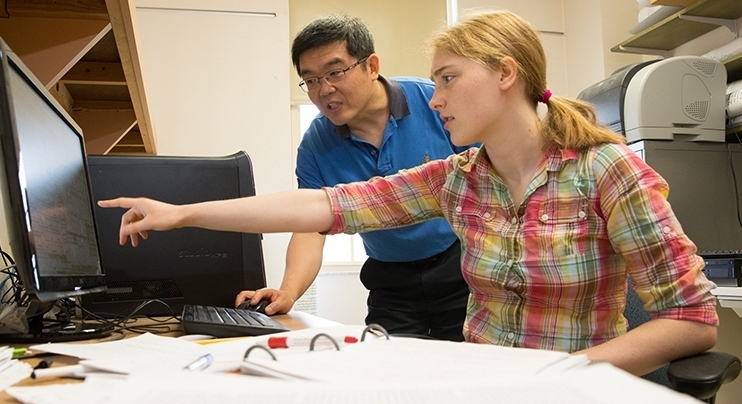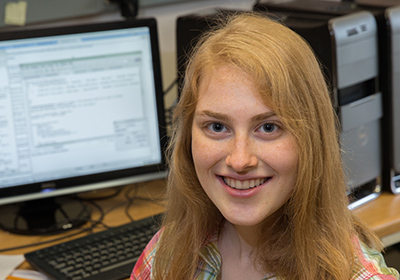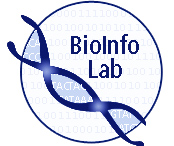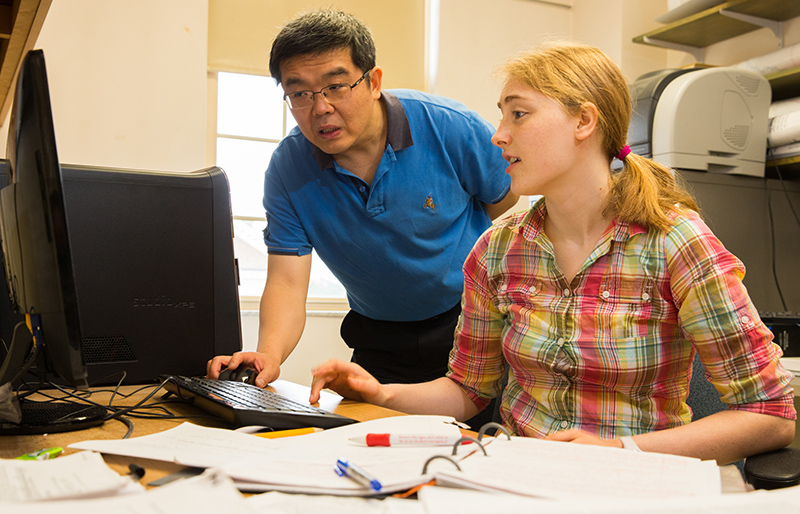

Lauren Misel: solving biological problems with computers
Lauren Misel, Miami-Hughes intern: bioinformatics research with Chun Liang, professor of biology
Part of a series of Miami Moments highlights on Undergraduate Research, summer 2015.

By Susan Meikle, university news and communications, meiklesb@MiamiOH.edu
Lauren Misel, a junior microbiology major and bioinformatics minor from Newark, had never taken a programming course until her sophomore year at Miami. Two semesters later she was selected as a Miami-Hughes intern, spending the summer conducting research and working on a software tool "CRISPR-Cas9 Target Prediction" with her faculty mentor Chun Liang, professor of biology.
From biology to computer science to bioinformatics
Misel first learned programming through the Introduction to Programming for the Life Sciences course (BIO/CSE/MBI 256) taught by John Karro, associate professor of computer science and software engineering.
"I really liked learning the programming — it is problem-solving daily," Misel said. "It's neat to study the major algorithms behind biological processes, such as the evolutionary distance between organisms."

More about Liang's Bioinformatics lab
Her first introduction to applications biology was through Miami's Bacteriophage Biology course (MBI 223/Bacteriophage Genomics MBI224 — restricted to first-year students).
Students purified their own viruses in that hands-on lab course. At Miami's Center for Advanced Microscopy and Imaging they used Scanning Electron Microscopy (SEM) to view the viruses at magnifications up to 50,000x.
During the second semester, students in the class chose one virus to be sent off for genome analysis, and then they used software tools to analyze it, Misel explained.
"I really liked learning the applications biology and wanted to learn more," Misel said.
Since then, she added bioinformatics as a minor and has been awarded a Choose Ohio First Bioinformatics Scholarship.
She started working formally in Liang's bioinformatics lab last January, after sitting in on weekly lab meetings during the previous fall semester.
Miami-Hughes project: Software prediction tool
Misel received a Miami-Hughes internship in the biological sciences, a Miami-funded program that provides a $3,000 stipend, a $750 research expense account and 12 hours of academic credit with tuition waived. Up to 15 students are selected for the program each summer to conduct a faculty-mentored research project.

Misel is a member of the university honors program. Liang is also an affiliate professor in computer science and software engineering.
She is working with Liang and his second-year doctoral student, Houxiang Zhu, on a software prediction program, CRISPR "Optimal Target Prediction and Visualization."
CRISPR — a breakthrough genome-editing technology — is a kind of biological scissors that can snip strands of DNA at a particular point. This allows for new genes to be inserted (such as a therapeutic enzyme) or knocked out (such as to study a mutation) before pasting the strands back together, Liang said. It is the next "big thing" in molecular biology.
 But CRISPR is not always so precise. For instance, it might cut where you don't want it to, or it might cut close to, but not exactly, at the intended point, Liang said.
But CRISPR is not always so precise. For instance, it might cut where you don't want it to, or it might cut close to, but not exactly, at the intended point, Liang said.
"We want to be able predict the best cutting matches and reduce the error," Liang said. One way to help is to use RNA guided sequences for more specific gene editing — CRISPR Cas9 — that looks for two matches before a "cut" is made.
Their software prediction tool — Optimal Target Prediction and Visualization for Genome Editing with CRISPR/Cas Systems — will allow other scientists to quickly determine the optimal RNA targets for their particular genomic research.
The open source web service will allow a user to upload DNA sequences, set specifications according to experimental goals and receive candidate guide RNA targets, Liang said.
Misel will be a co-author on the manuscript describing the use of the software prediction tool.
